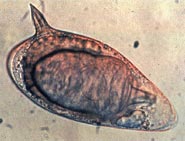
Comparative mitogenomics of freshwater snails of the genus Bulinus, obligatory vectors of Schistosoma haematobium, causative agent of human urogenital schistosomiasis
Sign Up to like & getrecommendations! Published in 2022 at "Scientific Reports"
DOI: 10.1038/s41598-022-09305-7
Abstract: Among the snail genera most responsible for vectoring human-infecting schistosomes, Bulinus, Biomphalaria, and Oncomelania, the former is in many respects the most important. Bulinid snails host the most common human blood fluke, Schistosoma haematobium, responsible… read more here.
Keywords: schistosomiasis; haematobium; comparative mitogenomics; schistosoma haematobium ... See more keywords

Population genetic structure of Schistosoma haematobium and Schistosoma haematobium × Schistosoma bovis hybrids among school-aged children in Côte d’Ivoire
Sign Up to like & getrecommendations! Published in 2022 at "Parasite"
DOI: 10.1051/parasite/2022023
Abstract: While population genetics of Schistosoma haematobium have been investigated in West Africa, only scant data are available from Côte d’Ivoire. The purpose of this study was to analyze both genetic variability and genetic structure among… read more here.
Keywords: bovis hybrids; schistosoma haematobium; schistosoma; haematobium ... See more keywords

Prospective cohort study using ultrasonography of Schistosoma haematobium infected migrants.
Sign Up to like & getrecommendations! Published in 2021 at "Journal of travel medicine"
DOI: 10.1093/jtm/taab122
Abstract: BACKGROUND Chronic infection with Schistosoma haematobium may lead to serious complications, including bladder carcinoma. Although it is recommended that only bladder masses not regressing within 6 months after praziquantel intake should be investigated invasively, cystoendoscopy is… read more here.
Keywords: bladder; schistosoma haematobium; study; pathology ... See more keywords

Ectopic cutaneous Schistosoma haematobium in the inguinal region
Sign Up to like & getrecommendations! Published in 2019 at "Journal of Travel Medicine"
DOI: 10.1093/jtm/taz011
Abstract: A 66-year-old man with indolent systemic mastocytosis presented with a plaque-like cutaneous lesion at his right inguinal region. He had travelled to various African countries in the years before. Pathological examination revealed a granulomatous infiltrate… read more here.
Keywords: cutaneous schistosoma; schistosoma haematobium; inguinal region; ectopic cutaneous ... See more keywords

In-depth proteomic characterization of Schistosoma haematobium: Towards the development of new tools for elimination
Sign Up to like & getrecommendations! Published in 2019 at "PLoS Neglected Tropical Diseases"
DOI: 10.1371/journal.pntd.0007362
Abstract: Background Schistosomiasis is a neglected disease affecting hundreds of millions worldwide. Of the three main species affecting humans, Schistosoma haematobium is the most common, and is the leading cause of urogenital schistosomiasis. S. haematobium infection… read more here.
Keywords: towards development; schistosoma haematobium; egg; new tools ... See more keywords

No pre-zygotic isolation mechanisms between Schistosoma haematobium and Schistosoma bovis parasites: From mating interactions to differential gene expression
Sign Up to like & getrecommendations! Published in 2021 at "PLoS Neglected Tropical Diseases"
DOI: 10.1371/journal.pntd.0009363
Abstract: Species usually develop reproductive isolation mechanisms allowing them to avoid interbreeding. These preventive barriers can act before reproduction, “pre-zygotic barriers”, or after reproduction, “post-zygotic barriers”. Pre-zygotic barriers prevent unfavourable mating, while post-zygotic barriers determine the… read more here.
Keywords: isolation mechanisms; zygotic barriers; differential gene; schistosoma haematobium ... See more keywords

“We know about schistosomiasis but we know nothing about FGS”: A qualitative assessment of knowledge gaps about female genital schistosomiasis among communities living in Schistosoma haematobium endemic districts of Zanzibar and Northwestern Tanzania
Sign Up to like & getrecommendations! Published in 2021 at "PLoS Neglected Tropical Diseases"
DOI: 10.1371/journal.pntd.0009789
Abstract: Background Schistosoma haematobium causes urogenital schistosomiasis and is widely distributed in Tanzania. In girls and women, the parasite can cause Female Genital Schistosomiasis (FGS), a gynecological manifestation of schistosomiasis that is highly neglected and overlooked… read more here.
Keywords: schistosomiasis; medicine; knowledge; schistosoma haematobium ... See more keywords

Genome-wide insights into adaptive hybridisation across the Schistosoma haematobium group in West and Central Africa
Sign Up to like & getrecommendations! Published in 2022 at "PLoS Neglected Tropical Diseases"
DOI: 10.1371/journal.pntd.0010088
Abstract: Schistosomiasis remains a public health concern across sub-Saharan Africa; current control programmes rely on accurate mapping and high mass drug administration (MDA) coverage to attempt disease elimination. Inter-species hybridisation can occur between certain species, changing… read more here.
Keywords: hybridisation; schistosoma haematobium; genome wide; guineensis ... See more keywords

Characterisation of tetraspanins from Schistosoma haematobium and evaluation of their potential as novel diagnostic markers
Sign Up to like & getrecommendations! Published in 2022 at "PLoS Neglected Tropical Diseases"
DOI: 10.1371/journal.pntd.0010151
Abstract: Schistosoma haematobium is the leading cause of urogenital schistosomiasis and it is recognised as a class 1 carcinogen due to the robust association of infection with bladder cancer. In schistosomes, tetraspanins (TSPs) are abundantly present… read more here.
Keywords: tsp tsp; schistosoma haematobium; infection; tsp ... See more keywords

Comparing the accuracy of two diagnostic methods for detection of light Schistosoma haematobium infection in an elimination setting in Wolaita Zone, South Western Ethiopia
Sign Up to like & getrecommendations! Published in 2022 at "PLoS ONE"
DOI: 10.1371/journal.pone.0267378
Abstract: Reagent urinalysis dipstick and filtration have been recommended diagnostic methods for the detection of urogenital schistosomiasis. However, the accurate diagnosis of light infections using these methods presents a major challenge. This study evaluates the diagnosis… read more here.
Keywords: diagnostic methods; schistosoma haematobium; infection; methods detection ... See more keywords

Detection of cytological abnormalities in urothelial cells from individuals previously exposed or currently infected with Schistosoma haematobium
Sign Up to like & getrecommendations! Published in 2023 at "PLOS ONE"
DOI: 10.1371/journal.pone.0278202
Abstract: Urinary schistosomiasis has long been associated with bladder cancer, but it is still not clear the mechanisms involved. Schistosoma haematobium causes injury and disruptions in the integrity of the urothelium. The cellular and immunologic responses… read more here.
Keywords: schistosoma haematobium; urothelial cells; schistosomiasis; haematobium ... See more keywords